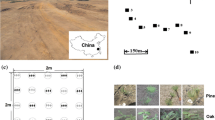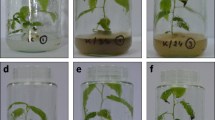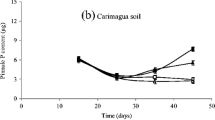Abstract
In this research, we investigate zinc phosphate transformations by Paxillus involutus/pine ectomycorrhizas using zinc-resistant and zinc-sensitive strains of the ectomycorrhizal fungus under high- and low-phosphorus conditions to further understand fungal roles in the transformation of toxic metal minerals in the mycorrhizosphere. Mesocosm experiments with ectomycorrhizas were performed under sterile conditions with zinc phosphate localized in cellophane bags: zinc and phosphorus mobilization and uptake by the ectomycorrhizal biomass were analyzed. In the presence of a phosphorus source, an ectomycorrhizal association with a zinc-resistant strain accumulated the least zinc compared to a zinc-sensitive ectomycorrhizal association and non-mycorrhizal plants. Under low-phosphorus conditions, mycorrhizal seedlings infected with the zinc-resistant strain increased the dissolution of zinc phosphate and zinc accumulation by the plant. Extended X-ray absorption fine structure analysis of both mycorrhizal and nonmycorrhizal roots showed octahedral coordination of zinc by oxygen-containing ligands such as carboxylates or phosphate. We conclude that zinc phosphate solubilization and zinc and phosphorus uptake by the association depend on ectomycorrhizal infection, strain of the mycobiont, and the phosphorus status of the matrix.






Similar content being viewed by others
References
Ahonen-Jonnarth, U, Finlay, RD (2001) Effects of elevated nickel and cadmium concentrations on growth and nutrient uptake of mycorrhizal and non-mycorrhizal Pinus sylvestris seedlings. Plant Soil 236: 129–138
Ahonen-Jonnarth, U, Goransson, A, Finlay, RD (2003) Growth and nutrient uptake of ectomycorrhizal Pinus sylvestris seedlings in a natural substrate treated with elevated Al concentrations. Tree Physiol 23: 157–167
Adriaensen, K, Van der Lelie, D, Van Laere, A, Vangrosveld, J, Colpaert, JV (2003) A zinc-adapted fungus protects pines from zinc stress. New Phytol 161: 549–555
Binsted, N (1998) Daresbury Laboratory EXCURV98 Program
Binsted, N, Strange, RW, Hasnain, SS (1992) Constrained and restrained refinement in EXAFS data analysis with curved wave theory. Biochem 31: 12117–12125
Brown, MT, Wilkins, DA (1985) Zinc tolerance of mycorrhizal Betula. New Phytol 99: 101–106
Brown, S, Chaney, R, Hallfrisch, J, Ryan, JA, Berti, WR (2004) In situ soil treatments to reduce the phyto- and bioavailability of lead, zinc, and cadmium. J Environ Qual 33: 522–531
Bu¨cking, H, Heyser, W (1999) Elemental composition and function of polyphosphates in ectomycorrhizal fungi—an X-ray microanalytical study. Mycol Res 103: 31–39
Burford, EP, Fomina, M, Gadd, GM (2003) Fungal involvement in bioweathering and biotransformation of rocks and minerals. Mineral Mag 67: 1127–1155
Burgstaller, W, Schinner, F (1993) Leaching of metals with fungi. J Biotechnol 27: 91–116
Burleigh, SH, Cavagnaro, T, Jakobsen, I (2002) Functional diversity of arbuscular mycorrhizas extends to the expression of plant genes involved in P nutrition. J Exp Bot 53: 1593–1601
Chen, X-B, Wright, JV, Conca, JL, Peurrung, LM (1997) Evaluation of heavy metal remediation using mineral apatite. Water Air Soil Pollut 98: 57–78
Colpaert, JV, Van Assche, JA (1992) Zinc toxicity in ectomycorrhizal Pinus sylvestris. Plant Soil 143: 201–211
Colpaert, JV, Vandenkoornhuyse, P, Adriaensen, K, Vangronsveld, J (2000) Genetic variation and heavy metal tolerance in the ectomycorrhizal basidiomycete Suillus luteus. New Phytol 147: 367–379
Colpaert, JV, Muller, LAH, Lambaerts, M, Andriaensen, K, Vangronsveld, J (2004) Evolutionary adaptation to Zn toxicity in populations of Suilloid fungi. New Phytol 162: 549–559
Conca, JL (1997) Phosphate-induced metal stabilization (PIMS). Final report to the U.S. Environmental Protection Agency 68D60023, Res. Triangle Park, NC
Duff, SMG, Sarath, G, Plaxton, WC (1994) The role of acid phosphatases in plant phosphorus metabolism. Physiol Plant 90: 791–800
Fomina, M, Alexander, IJ, Hillier, S, Gadd, GM (2004) Zinc phosphate and pyromorphite solubilization by soil plant-symbiotic fungi. Geomicrobiol J 21: 351–366
Fomina, M, Alexander, IJ, Colpaert, JV, Gadd, GM (2005) Solubilization of toxic metal minerals and metal tolerance of mycorrhizal fungi. Soil Biol Biochem 37: 857–866
Gadd, GM (1993) Interactions of fungi with toxic metals. New Phytol 124: 25–60
Gilroy, S, Jones, DL (2000) Through form to function: root hair development and nutrient uptake. Trends Plant Sci 5: 56–60
Greger, M (1999) Metal availability and bioconcentration in plants. In: Prasad, MNV, Hagemeyer, J (Eds.) Heavy Metal Stress in Plants from Molecules to Ecosystem. Springer-Verlag, Berlin, Heidelberg, Germany, pp 1–27
Gurman, SJ, Binsted, N, Ross, I (1984) A rapid, exact, curved-wave theory for EXAFS calculations. J Phys Chem 17: 143–151
Gurman, SJ, Binsted, N, Ross, I (1986) A rapid, exact, curved-wave theory for EXAFS calculations. 2. The multiple-scattering contributions. J Phys Chem 19: 1845–1861
Hartley-Whitaker, J, Cairney, JWG, Meharg, AA (2000) Sensitivity to Cd and Zn of host and symbiont of ectomycorrhizal Pinus sylvestris L. (Scots pine) seedlings. Plant Soil 218: 31–42
Hedin, L, Lundqvist, S (1969) Effects of electron–electron and electron–phonon interactions on the one-electron states of solids. Solid State Phys 23: 1–181
Heuwinkel, H, Kirkby, EA, Bot, J Le, Marschner, H (1992) Phosphorus deficiency enhances molybdenum uptake by tomato plants. J Plant Nutr 15: 549–568
Horst, WJ, Kamh, M, Jibrin, JM, Chude, VA (2001) Agronomic measures for increasing P availability to crops. Plant Soil 237: 211–233
Huang, C, Barker, SJ, Langridge, P, Smith, FW, Graham, D (2000) Zinc deficiency up-regulates expression of high-affinity phosphatetransporter genes in both phosphate-sufficient and -deficient barley roots. Plant Physiol 124: 415–422
Ingestad, T (1979) Mineral nutrient requirements of Pinus sylvestris and Picea abies seedlings. Physiol Plant Pathol 45: 373–380
Jentschke, G, Godbold, DL (2000) Metal toxicity and ectomycorrhizas. Physiol Plant 109: 107–116
Jones, MD, Hutchinson, TC (1988) Nickel toxicity in mycorrhizal birch seedlings infected with Lactarius rufus or Scleroderma flavidum. II Uptake of nickel, calcium, magnesium, phosphorus and iron. New Phytol 108: 461–470
Jongmans, AG, Van Breemen, N, Lundstrom, U, Van Hees, PAW, Finlay, RD, Srinivasan, M, Unestam, T, Giesler, R, Melkerud, PA, Olsson, M (1997) Rock-eating fungi. Nature 389: 682–683
Koide, RT, Kabir, Z (2001) Nutrient economy of red pine affected by interactions between Pisolithus tinctorius and other forest-floor microbes. New Phytol 105: 179–188
Lajtha, K, Harrison, AF (1995) Strategies of phosphorus acquisition and conservation by plant species and communities. In: Tiessen, H (Ed.) Phosphorus in the Global Environment. John Wiley Sons Ltd, Chichester, UK, pp 140–147
Lapeyrie, F, Ranger, J, Vairelles, D (1991) Phosphate-solubilizing activity of ectomycorrhizal fungi in vitro. Can J Bot 69: 342–346
Lapeyrie, F, Ranger, J, Vairelles, D (1991) Phosphate-solubilizing activity of ectomycorrhizal fungi in vitro. Can J Bot 69: 342–346
Lundstrom, US, Van Breemen, N, Bain, D (2000) The podzolization process. A review. Geoderma 94: 91–107
Lynch, JP, Brown, KM (2001) Topsoil foraging—an architectural adaptation of plants to low phosphorus. Plant Soil 237: 225–237
Macfall, J, Slack, SA, Iyer, J (1991) Effects of Hebeloma arenosa and phosphorus fertility on growth of red pine (Pinus resinosa) seedlings. Can J Bot 69: 372–379
Marschner, H, Römheld, V, Horst, WJ, Martin, P (1986) Root induced changes in the rhizosphere: importance for mineral nutrition of plants. Z Pflanzenernähr Bodenkd 149: 441–456
Martino, E, Perotto, S, Parsons, R, Gadd, GM (2003) Solubilization of insoluble inorganic zinc compounds by ericoid mycorrhizal fungi derived from heavy metal polluted sites. Soil Biol Biochem 35: 133–141
Meharg, AA (2003) The mechanistic basis of interactions between mycorrhizal associations and toxic metal cations. Mycol Res 107: 1253–1265
Meharg, AA, Cairney, JWG (2000) Co-evolution of mycorrhizal symbionts and their hosts to metal-contaminated environments. Adv Ecol Res 30: 69–112
Olsen, SR, Sommers, LE (1982) Phosphorus. In: Page, AL, Miller, RH, Keeney, DR (Eds.) Methods of Soil Analysis. Part 2, Chemical and Microbiological Properties. American Society of Agronomy, Madison, USA, pp 403–429
Perotto, S, Martino, E (2001) Molecular and cellular mechanisms of heavy metal tolerance in mycorrhizal fungi: what perspectives for bioremediation? Minerva Biotechnol 13: 55–63
Peterson, RL, Chakravarty, P (1991) In: Norris, JR, Read, DJ, Varma, AK (Eds.) Techniques for Mycorrhizal Research. Academic Press, London, pp 75–105
Sarret, G, Manceau, A, Cuny, D, Van Haluwyn, C, Deruelle, S, Hazemann, J-L, Soldo, Y, Eybert-Berard, L, Menthonnex, J-J (1998) Mechanisms of lichen resistance to metallic pollution. Environ Sci Technol 32: 3325–3330
Sarret, G, Saumitou-Laprade, P, Bert, V, Proux, O, Hazemann, J-L, Traverse, A, Marcus, MA, Manceau, A (2002) Forms of zinc accumulated in the hyperaccumulator Arabidopsis halleri. Plant Physiol 130: 1815–1826
Sarret, G, Balesdent, J, Bouziri, L, Garnier, J-M, Marcus, MA, Geoffroy, N, Panfili, F, Manceau, A (2004) Zn speciation in the organic horizon of a contaminated soil by micro-X-ray fluorescence, micro- and powder-EXAFS spectroscopy, and isotopic dilution. Environ Sci Technol 38: 2792–2801
Sayer, JA, Raggett, SL, Gadd, GM (1995) Solubilization of insoluble compounds by soil fungi: development of a screening method for solubilizing ability and metal tolerance. Mycol Res 99: 987–993
Sayer, JA, Cotter-Howells, JD, Watson, C, Hillier, S, Gadd, GM (1999) Lead mineral transformation by fungi. Curr Biol 9: 691–694
Setala, H, Rissanen, J, Markkola, AM (1997) Conditional outcomes in the relationship between pine and ectomycorrhizal fungi in relation to biotic and abiotic environment. Oikos 80: 112–122
Schwamberger, EC, Sims, JL (1991) Effect of soil pH, nitrogen source, phosphorus, and molybdenum on early growth and mineral nutrition of burley tobacco. Commun Soil Sci Plant Anal 22: 641–657
Schachtman, DP, Reid, RJ, Ayling, SM (1998) Phosphorus uptake by plants: from soil to cell. Plant Physiol 116: 447–453
Shetty, KG, Hetrick, BAD, Schwab, AP (1995) Effects of mycorrhizae and fertilizer amendments on zinc tolerance of plants. Environ Pollut 88: 307–314
Sjöström, E (1993) Wood chemistry. Fundamentals and Applications. 2nd ed. Academic Press Inc. Orlando, FL, USA
Smith, FW, Rae, AL, Hawkesford, MJ (2000) Molecular mechanisms of phosphate and sulfate transport in plants. Biochim Biophys Acta 1465: 236–245
Sundén, A, Brelid, H, Rindby, A, Engström, P (2000) Spatial distribution and modes of chemical attachment of metal ions in spruce wood. J Pulp Paper Sci 26: 352–357
Tibbett, M, Sanders, FE (2002) Ectomycorrhizal symbiosis can enhance plant nutrition through improved access to discrete organic nutrient patches of high resource quality. Ann Bot 89: 783–789
Van Tichelen, KK, Colpaert, JV, Vangronsveld, J (2001) Ectomycorrhizal protection of Pinus sylvestris against copper toxicity. New Phytol 150: 203–213
Topa, MA, Cheeseman, JM (1992) Carbon and phosphorus partitioning in Pinus serotina seedlings growing under hypoxic and low-phosphorus conditions. Tree Physiol 10: 195–207
Vance, CP (2001) Symbiotic nitrogen fixation and phosphorus acquisition: plant nutrition in a world of declining renewable resources. Plant Physiol 127: 390–397
Vance, CP, Uhde-Stone, C, Allan, DL (2003) Phosphorus acquisition and use: critical adaptations by plants for securing a non-renewable resource. New Phytol 157: 423–447
Vodnik, D, Jentschke, G, Fritz, E, Gogala, N, Godbold, DL (1999) Root-applied cytokinin reduces lead uptake and affects its distribution in Norway spruce seedlings. Plant Physiol 106: 75–81
Wallander, H, Wickman, T, Jacks, G (1997) Apatite as a P source in mycorrhizal and non-mycorrhizal Pinus sylvestris seedlings. Plant Soil 196: 123–131
Whitelaw, MA (2000) Growth promotion of plants inoculated with phosphate-solubilizing fungi. Adv Agron 69: 99–151
Acknowledgments
This research was funded by the BBSRC/BIRE program (94/BRE13640), BNFL, and CCLRC Daresbury SRS (SRS user grant 40107). We thank Dr. Jan Colpaert and Miss Kristin Adriaensen (Limburgs University Centre, Belgium) for the provision of fungal strains. We are very grateful to Dr. Lorrie Murphy and Dr. Fred Mosselmans (Stations 7.1, CLRC Daresbury SRS, UK) for their help with X-ray absorption spectroscopy and to Mr. Martin Kierans [Centre for High Resolution Imaging and Processing (CHIPs), School of Life Sciences, University of Dundee, Scotland] for assistance with cryo-scanning electron microscopy. We are also very grateful to Prof. John Raven FRS (School of Life Sciences, University of Dundee) for helpful discussions.
Author information
Authors and Affiliations
Corresponding author
Rights and permissions
About this article
Cite this article
Fomina, M., Charnock, J.M., Hillier, S. et al. Zinc Phosphate Transformations by the Paxillus involutus/Pine Ectomycorrhizal Association. Microb Ecol 52, 322–333 (2006). https://doi.org/10.1007/s00248-006-9004-5
Received:
Accepted:
Published:
Issue Date:
DOI: https://doi.org/10.1007/s00248-006-9004-5




